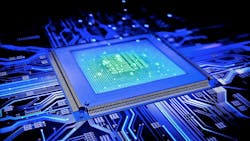Wanted: cyber-hardened high-performance embedded computing, artificial intelligence (AI), machine learning
ROME, N.Y. – U.S. Air Force researchers are approaching industry for new kinds of high-performance embedded computing designs with artificial intelligence (AI) and machine learning capabilities, as well as low size, weight, and power consumption (SWaP) for future military applications.
Officials of the Air Force Research Laboratory Information Directorate in Rome, N.Y., re-issued a broad agency announcement on Thursday (FA875019S7010) for the Advancing Computing Technology and Applications project. The original solicitation came out last year.
The project seeks to develop sophisticated computational capabilities with autonomy, intelligence, and assurance for command, control, communications, computers, intelligence, surveillance and reconnaissance (C4ISR) applications and other SWaP-constrained uses.
Of particular interest are high-performance embedded computing (HPEC) designs with AI and machine learning capabilities for on-board processing. Also of interest are design and development tools to decrease development times and system costs.
For high-performance embedded computing, the project seeks to explore processor architectures for future Air Force real-time embedded computing applications in digital signal processing (DSP), field-programmable gate arrays (FPGAs), graphics processing units (GPUs), and neuromorphic computing architectures.
This research includes multi-core and many-core parallelism for SWaP-constrained applications. Other research will include cyber hardening for trusted computing; high speed input/output (I/O); and heterogeneous computer systems.
Email questions about this technical area to Mark Barnell at [email protected] and Courtney Raymond at [email protected].
For neuromorphic computing and machine learning applications the project seeks to develop computationally intelligent systems, including beyond-Von Neumann-based computers like memristive systems, hardware-based neural networks, reservoir computing, chaotic systems, and advanced software algorithms.
Related: Artificial intelligence and embedded computing for unmanned vehicles
A specific interest is embedded deep learning that focuses on embedded computing machine learning, including trusted machine learning secured against enemy cyber attack. Emerging applications of interest include pattern recognition and signature analysis, autonomous adaptive operations, human-machine collaboration, neural control of complex systems, in situ training, and self-learning of neural networks.
Email questions about this technical area to Clare Thiem at [email protected] or Courtney Raymond at [email protected].
For nanocomputing, the project seeks to develop nanoelectronics and nanophotonics for high-performance and low-power computing using emerging nanomaterials and processes.
Nanoelectronics of interest include memristive; nanophotonic; spintronic; carbon-based; hybrid complementary metal oxide semiconductor (CMOS); spike processing; and synthetic neurons in bio-inspired architectures.
Email questions about this technical area to Joseph Van Nostrand at [email protected] or Courtney Raymond at [email protected].
The Air Force is asking industry now for three-to-five-page white papers. Those submitting promising white papers may be invited to submit full proposals. Email white papers to Courtney Raymond at [email protected] no later than 31 May 2021 for 2022 awards; 31 May 2022 for 2023 awards; and 31 May 2023 for 2024 awards. White papers will be accepted until 29 Sept. 2024. Deadlines for 2020 and 2021 awards already have passed.
Email technical questions or concerns to Courtney Raymond at [email protected]. Email contracting or business questions to Amber Buckley at [email protected].
More information is online at https://beta.sam.gov/opp/b8b42b1de7cc492eb8aa86020186fa7e/view.

John Keller | Editor-in-Chief
John Keller is the Editor-in-Chief, Military & Aerospace Electronics Magazine--provides extensive coverage and analysis of enabling electronics and optoelectronic technologies in military, space and commercial aviation applications. John has been a member of the Military & Aerospace Electronics staff since 1989 and chief editor since 1995.

